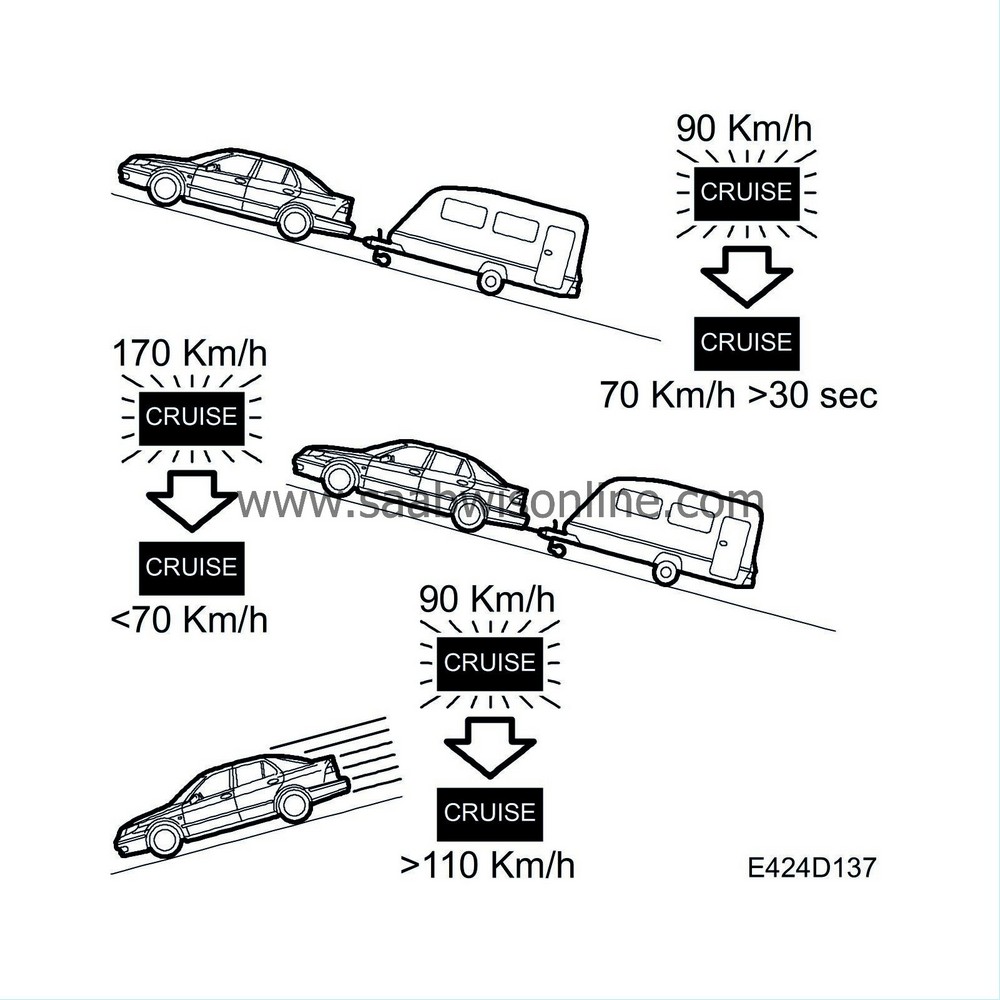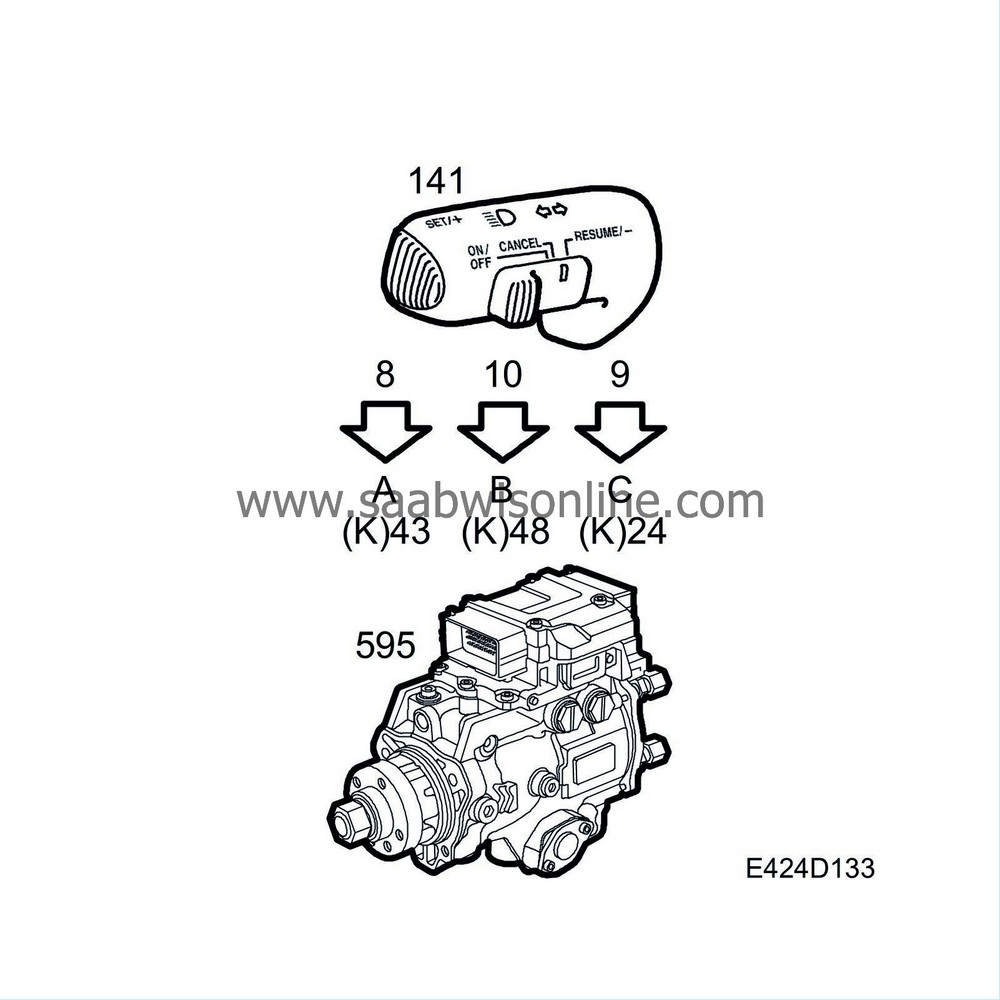Cruise control
| Cruise control |

The cruise control function is completely integrated in the engine control module and is operated with a switch on the direction indicator stalk switch. The control module processes the position of the switch, the vehicle speed and the gear ratio between the engine and the drive wheels. The result of these calculations is converted into a requested fuel quantity, which is carried forward in the control module's decision process.
The switch is supplied with +54 and has three outputs to the control module.
When the switch is put in the ON position, the control module sends bus information "cruise lamp ON". The main instrument unit then turns on the CRUISE lamp.
Cruise control comprises four sub-functions:

| - |
Evaluation of the cruise control switch
|
|
| - |
Shut-off conditions
|
|
| - |
Gear position identification
|
|
| - |
Cruise control functions
|
|
| Evaluation of the cruise control switch |
This function analyses the digital information from the switch, which the driver operates to obtain the desired function from the cruise control.
When evaluating the position of the switch, a plausibility assessment is made of the switch. This is performed by only allowing approved combinations of on and off for the different switch positions. If a disallowed combination of on/off occurs, a cruise control fault is generated and cruise control is disengaged.
| Activation |
Cruise control cannot be engaged if
| - |
The vehicle speed exceeds 220 km/h
|
|
| - |
The vehicle speed is below 25 km/h
|
|
| Shut-off conditions |

The shut-off conditions sub-function monitors a number of different parameters to determine if cruise control is to be allowed to continue. If any of the following conditions are met, cruise control will be disengaged.
| - |
OFF position from cruise control switch.
|
|
| - |
Logic error in brake switches.
|
|
| - |
The clutch is depressed or there is a fault in the cruise control clutch switch.
|
|
| - |
Cruise control fault according to the control module.
|
|
| - |
The vehicle speed exceeds 230 km/h.
|
|
| - |
The vehicle speed is below 25 km/h.
|
|
| - |
The engine speed above 4500 rpm.
|
|
| - |
The engine speed is below 1000 rpm.
|
|
| - |
The ratio between the current vehicle speed and engine speed is lower than 13.8 km/h/1000 rpm, i.e. first gear.
|
|
| - |
The ratio between the current vehicle speed and engine speed and the ratio between the vehicle speed and engine speed when cruise control is active is greater than 31.25 km/h/1000 rpm. This means that if the clutch switch has not disengaged cruise control but the gear ratio has still changed, it is assumed that the clutch switch is defective.
|
|
| - |
Ignition OFF.
|
|
If cruise control is in the "retain set speed" position and the accelerator is not touched, cruise control will also be disengaged if the following conditions are met.

| - |
If the current vehicle speed falls below the cruise control speed setting by more than 20 km/h for more than 30 seconds.
|
|
| - |
If the current vehicle speed falls below the cruise control speed setting by more than 100 km/h.
|
|
| - |
If the current vehicle speed exceeds the cruise control speed setting by more than 20 km/h.
|
|
| Gear position identification |
The gear position identification sub-function identifies the current gear position. By comparing the engine speed with the current vehicle speed, the gear position can be identified.
| Switch positions |
|
From switch pin
|
To control module pin
|
Connection designation in diagnostic tool
|
SWITCH POSITION
|
||||
|
Zero position
|
ON/OFF
|
SET/+
|
RESUME/-
|
CANCEL
|
|||
|
8
|
43
|
A
|
0
|
1
|
0
|
0
|
0
|
|
10
|
48
|
B
|
0
|
1
|
1
|
0
|
1
|
|
9
|
24
|
C
|
0
|
1
|
0
|
1
|
1
|
Zero position
The switch is spring-loaded to the neutral position. None of the switch connections A, B or C is live.ON/OFF
When the switch is moved to the far left, connections A, B and C are supplied with current. The ON/OFF position has two functions, alternately ON and OFF.CANCEL
Between the neutral position and ON/OFF, switch connections B and C are supplied with current. The position has the same function as pressing the brake or clutch pedal, i.e. the cruise control is disengaged but the set speed is retained in the memory.RESUME/-
When the switch is moved to the far right from the neutral position, connection C is supplied with current. The position has three functions:| 1. |
Engages the cruise control and stores the current speed in the memory if no speed has already been stored there.
|
|
| 2. |
Engages the cruise control if a speed is stored in the memory but the cruise control function has been disengaged with CANCEL, the brake pedal or the clutch pedal.
|
|
| 3. |
If the position is selected while the cruise control is active, the speed will be reduced. When the control returns to the neutral position, the current speed will be stored and the cruise control function continues.
|
|
If the position is selected for a shorter time than 0.5 sec., the requested speed is reduced by 1.6 km/h (1 mph).
SET/+
At the end of the direction indicator stalk is a spring-loaded pushbutton. When this button is pressed in, current is supplied to connection B. The position has two functions:| 1. |
Engages cruise control and stores the current speed in the memory regardless of whether another speed is already stored in the memory.
|
|
| 2. |
With the button pressed in, vehicle speed increases. When the button is released, the current speed is stored and the cruise control function continues.
|
|
If the button is pressed for a shorter time than 0.5 sec., the requested speed is increased by 1.6 km/h (1 mph).



